Hello.
I've been having problems with my radiators for a while now. I live on the 4th floor of a block of flats. The gurgling radiator is in the bathroom (separate riser for the radiator in the bathroom). There is also a valve for closing and opening the flow in the upper right corner (unscrewed to the max). There is a vent on the top left.
I'll post pictures of the whole setup on Wednesday.
Thank you.
Goodbye.
I've been having problems with my radiators for a while now. I live on the 4th floor of a block of flats. The gurgling radiator is in the bathroom (separate riser for the radiator in the bathroom). There is also a valve for closing and opening the flow in the upper right corner (unscrewed to the max). There is a vent on the top left.
I'll post pictures of the whole setup on Wednesday.
Thank you.
Goodbye.







